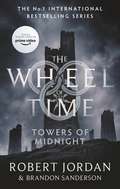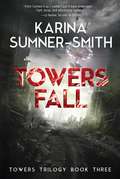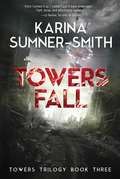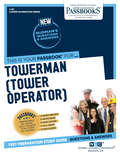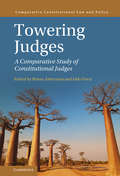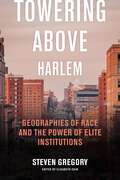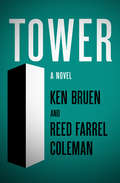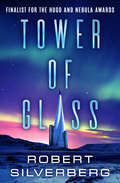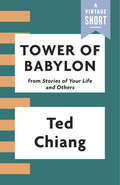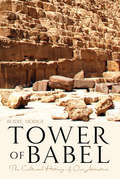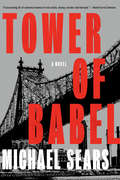- Table View
- List View
Towers Of Midnight: Book 13 of the Wheel of Time (soon to be a major TV series) (Wheel of Time #19)
by Robert Jordan Brandon SandersonSoon to be a major Amazon Prime TV series The thirteenth novel in the Wheel of Time series - one of the most influential and popular fantasy epics ever published.The Last Battle has started. The seals on the Dark One's prison are crumbling. The Pattern itself is unravelling, and the armies of the Shadow have begun to spill out of the Blight.Perrin Aybara is haunted by spectres from his past. To prevail, he must find a way to master the wolf within him or lose himself to it for ever.Meanwhile, Matrim Cauthon prepares for the most difficult challenge of his life. The Tower of Ghenjei awaits, and its secrets will reveal the fate of a friend long lost.The end draws near. It's time to roll the dice.'Epic in every sense' Sunday Times'With the Wheel of Time, Jordan has come to dominate the world that Tolkien began to reveal' New York Times'[The] huge ambitious Wheel of Time series helped redefine the genre' George R. R. Martin'A fantasy phenomenon' SFXThe Wheel of TimeThe Eye of the WorldThe Great HuntThe Dragon RebornThe Shadow RisingThe Fires of HeavenLord of ChaosA Crown of SwordsThe Path of DaggersWinter's HeartCrossroads of TwilightKnife of DreamsThe Gathering StormTowers of MidnightA Memory of LightNew Spring (prequel) The Wheel of Time Companion
Towers Falling
by Jewell Parker RhodesFrom award-winning author Jewell Parker Rhodes, a powerful novel set fifteen years after the 9/11 attacks. <P><P>When her fifth-grade teacher hints that a series of lessons about home and community will culminate with one big answer about two tall towers once visible outside their classroom window, Deja can't help but feel confused. <P>She sets off on a journey of discovery, with new friends Ben and Sabeen by her side. <P>But just as she gets closer to answering big questions about who she is, what America means, and how communities can grow (and heal), she uncovers new questions, too. <P>Like, why does Pop get so angry when she brings up anything about the towers? <P>Award-winning author Jewell Parker Rhodes tells a powerful story about young people who weren't alive to witness this defining moment in history, but begin to realize how much it colors their every day.
Towers Fall: Towers Trilogy Book Three (Towers Trilogy)
by Karina Sumner-SmithWar. Fire. Destruction. Xhea believed that the Lower City had weathered the worst of its troubles--that their only remaining fight would be the struggle to rebuild before winter. She was wrong. Now her home is under attack from an unexpected source. The Central Spire, the City’s greatest power, is intent on destroying the heart of the magical entity that resides beneath the Lower City’s streets. The people on the ground have three days to evacuate--or else. With nowhere to go and time running out, Xhea and the Radiant ghost Shai attempt to rally a defense. Yet with the Spire’s wrath upon them, nothing--not their combined magic, nor their unexpected allies--may be strong enough to protect them from the power of the City. From Nebula Award-nominated author Karina Sumner-Smith, Towers Fall is a fantastic climax to this amazing and thought-provoking trilogy.
Towers Fall: Towers Trilogy Book Three (Towers Trilogy Ser. #3)
by Karina Sumner-SmithWar. Fire. Destruction. Xhea believed that the Lower City had weathered the worst of its troubles-that their only remaining fight would be the struggle to rebuild before winter. She was wrong.Now her home is under attack from an unexpected source. The Central Spire, the City's greatest power, is intent on destroying the heart of the magical entity that resides beneath the Lower City's streets. The people on the ground have three days to evacuate-or else.With nowhere to go and time running out, Xhea and the Radiant ghost Shai attempt to rally a defense. Yet with the Spire's wrath upon them, nothing-not their combined magic, nor their unexpected allies-may be strong enough to protect them from the power of the City.From Nebula Award-nominated author Karina Sumner-Smith, Towers Fall is a fantastic climax to this amazing and thought-provoking trilogy.
Towerman: Passbooks Study Guide (Career Examination Series)
by National Learning CorporationThe Towerman (Tower Operator) Passbook® prepares you for your test by allowing you to take practice exams in the subjects you need to study. It provides hundreds of questions and answers in the areas that will likely be covered on your upcoming exam, including but not limited to: interlocking machines; knowledge of operating timetables; safety and emergency procedures; transportation rules and regulations; tools and equipment; and more.
Towering Judges: A Comparative Study of Constitutional Judges (Comparative Constitutional Law and Policy)
by Iddo Porat Rehan AbeyratneIn Towering Judges: A Comparative Study of Constitutional Judges, Iddo Porat and Rehan Abeyratne lead an exploration of a new topic in comparative constitutional law: towering judges. The volume examines the work of twenty judges from fifteen jurisdictions, each of whom stood out individually among their fellow judges and had a unique impact on the trajectory of constitutional law. The chapters ask: what makes a towering judge; what are the background conditions that foster or deter the rise of towering judges; whether towering judges, on balance, are positive or detrimental for constitutional systems; how towering judges differ from one jurisdiction to another; how political and historical developments relate to this phenomenon; and how it fits within global constitutionalism. The answers to these questions offer important insight into exactly how these judges were able to shine to an uncommon degree in a profession where individualism is not always looked on favorably.
Towering Above Harlem: Geographies of Race and the Power of Elite Institutions
by Steven GregoryCharts racialized and class-based exclusion in Morningside Heights and its surrounding area by elite institutionsNew York City’s storied diversity has also been a story of racialized class discrimination. Towering Above Harlem focuses on understudied players in this process: the elite institutions of Morningside Heights—Columbia University, Teachers College and the Riverside Church—to reveal the troubling ways in which they exploited existing geographic features to build a racially and economically exclusive “city on a hill.”In his final book-length work, Steven Gregory explores the long history of economic and racial discrimination in Morningside Heights, beginning in the late 19th century and extending into the present day. This exclusion of the surrounding racial minorities and working-class population has been enacted physically, through the acquisition of property by Columbia and others, but it has also been enacted through a variety of discourses and practices aimed at setting apart the so-called “civilization-building” mission of the elites overlooking Harlem from the racialized others in the vicinity. The book shows that the major institutions of Morningside Heights have since the beginning tried to physically secede from the Black and Puerto Rican communities geographically below the Morningside plateau, while also symbolically rising above them as beacons of progress. The volume charts the coordinated effort among elites to use space to naturalize relations of power and prestige, illuminating the past, present, and uncertain future of racial discrimination and exclusivity in Morningside Heights and in New York City at large.
Towering
by Alex FlinnHigh in my tower I sit. I watch the birds fly below, the clouds float above, and the tall, green forest stretch to places I might never see. Mama, who isnt my mother, has kept me hidden away for many years. My only companions, besides Mama, are my books--great adventures, mysteries, and romances that I long to make my reality. But I know that no one will come to save me--my life is not a fairy tale after all. Well, at least no one has come so far. Recently, my hair has started to grow rapidly and its now long enough to reach the bottom of the tower from my window. Ive also had the strangest dreams of a beautiful, green-eyed man. When Mama isnt around, I plan my escape, even if its just for a little while. Theres something--maybe someone--waiting for me out there and it wont find me if Im trapped here towering above it all.
TowerBrook: ESG in Action (B)
by Victoria Ivashina Brian Trelstad Meaghan ConwayThis case is the second of a two-part series that follows Ramez Sousou and his team at TowerBrook Capital Partners as they face a challenging investment decision in February of 2013. It is intended to be distributed at the end of the of the discussion of "TowerBrook: ESG in Action (A)" (HBS No. 221-046). This case describes the outcome of the investment decision and the steps that TowerBrook has taken since 2013 to systematically address ESG considerations across the life cycle of their deals. It also discusses TowerBrook's B Corp certification process.
TowerBrook: ESG in Action (A)
by Victoria Ivashina Brian Trelstad Meaghan ConwayThis case is the first of a two-part series that follows Ramez Sousou and his team at TowerBrook Capital Partners as they face a challenging investment decision in February of 2013. Since its founding, TowerBrook has prided itself on its purpose-driven investing philosophy and responsible ownership practices, seeking to incorporate these ideals in each step of the life cycle of a deal. Thus, the TowerBrook investment process extends beyond financial returns and consideration for the bottom-line. This investment decision was a tough one: some TowerBrook team members were excited about the company's growth potential, while others were concerned about the optics of its social impact. Overall, this case can be used to understand how private equity firms are integrating ESG considerations into their decision-making processes.
Tower: An Epic History of the Tower of London
by Nigel JonesA dazzling history of the Tower of London, one of the world's busiest tourist attractions, and the people who populated it.Castle, royal palace, prison, torture chamber, execution site, zoo, mint, home to the crown jewels, armory, record office, observatory, and the most visited tourist attraction in the UK: The Tower of London has been all these things and more. No building in Britain has been more intimately involved in the island's story than this mighty, brooding stronghold in the very heart of the capital, a place which has stood at the epicenter of dramatic, bloody and frequently cruel events for almost a thousand years.Now historian Nigel Jones sets this dramatic story firmly in the context of national—and international—events. In a gripping account drawn from primary sources and lavishly illustrated with sixteen pages of stunning photographs, he captures the Tower in its many changing moods and its many diverse functions. Here, for the first time, is a thematic portrayal of the Tower of london not just as an ancient structure, but as a living symbol of the nation of Great Britain.
Tower: A Novel
by Ken Bruen Reed Farrel ColemanThe author of Blitz and the author of the Jesse Stone novels collaborate on a &“rough and profane read&” about two childhood friends who become criminals (Daniel Woodrell). Nick&’s Irish-American father, a Brooklyn rent-a-cop working security in the World Trade Center&’s North Tower, named him after a Hemingway hero. The old man must have been expecting a different kind of kid. Because, like the R&B song says, Nick was born under a bad sign. As aimless as a stray bullet, his only constants are &’Nam movies, pulp novels, and an unquestioning devotion to his childhood friend, Todd, a Jewish New York con artist with connections to the Boston mob. When Todd inducts Nick into his world of petty crime, it starts with reckless fun—scoring weed, low-level stings, and burglary. But the deeper they sink into the world of the syndicate, the more they realize how unknowable a friend can be, and how unprepared they are to rescue themselves, and their souls, from the gutter. Alternately telling this &“brutally poetic&” story from the perspectives of Nick and Todd, award-winning &“noir masters&” Ken Bruen and Reed Farrel Colemen &“shine, dropping in-jokes, experimenting and displaying all the literary chops that have made their novels such cult favorites among mystery fans&” (Publishers Weekly).
Tower: A Novel
by Ken Bruen Reed Farrel ColemanThe author of Blitz and the author of the Jesse Stone novels collaborate on a &“rough and profane read&” about two childhood friends who become criminals (Daniel Woodrell). Nick&’s Irish-American father, a Brooklyn rent-a-cop working security in the World Trade Center&’s North Tower, named him after a Hemingway hero. The old man must have been expecting a different kind of kid. Because, like the R&B song says, Nick was born under a bad sign. As aimless as a stray bullet, his only constants are &’Nam movies, pulp novels, and an unquestioning devotion to his childhood friend, Todd, a Jewish New York con artist with connections to the Boston mob. When Todd inducts Nick into his world of petty crime, it starts with reckless fun—scoring weed, low-level stings, and burglary. But the deeper they sink into the world of the syndicate, the more they realize how unknowable a friend can be, and how unprepared they are to rescue themselves, and their souls, from the gutter. Alternately telling this &“brutally poetic&” story from the perspectives of Nick and Todd, award-winning &“noir masters&” Ken Bruen and Reed Farrel Colemen &“shine, dropping in-jokes, experimenting and displaying all the literary chops that have made their novels such cult favorites among mystery fans&” (Publishers Weekly).
Tower to Tower: Gigantism in Architecture and Digital Culture (The\mit Press Ser.)
by Henriette Steiner Kristin VeelA cultural history of gigantism in architecture and digital culture, from the Eiffel Tower to the World Trade Center.The gigantic is everywhere, and gigantism is manifest in everything from excessively tall skyscrapers to globe-spanning digital networks. In this book, Henriette Steiner and Kristin Veel map and critique the trajectory of gigantism in architecture and digital culture—the convergence of tall buildings and networked infrastructures—from the Eiffel Tower to One World Trade Center. They show how these two forms of gigantism intersect in the figure of the skyscraper with a transmitting antenna on its roof, a gigantic building that is also a nodal point in a gigantic digital infrastructure.Steiner and Veel focus on two paradigmatic tower sites: the Eiffel Tower and the Twin Towers of the destroyed World Trade Center (as well as their replacement, the One World Trade Center tower). They consider, among other things, philosophical interpretations of the Eiffel Tower; the design and destruction of the Twin Towers; the architectural debates surrounding the erection of One World Trade Center on the Ground Zero site; and such recent examples of gigantism across architecture and digital culture as Rem Koolhaas's headquarters for China Central TV and the phenomenon of the “tech giant.” Examining the cultural, architectural, and media history of these towers, they analyze the changing conceptions of the gigantism that they represent, not just as physical structures but as sites for the projection of cultural ideas and ideals.
Tower of the Winds: Book 4 (Secret Breakers #4)
by H L DennisThe Knights of Neustria's quest is clearer to Team Veritas now - but so is their understanding of the terrible enemy they are up against. People are going missing. No one at Station X is safe anymore. But there are still important truths to uncover.Which secret organization is protecting the work of the Knights of Neustria and do they know who is buried in the unmarked Shepherd's Tomb at Shugborough Hall? Will the story of the mysterious treasure ship 'The Covadogna' help the team of secret breakers discover more about the world described in the ancient coded Voynich Manuscript? And will every member of the team survive the race against time when the sinister Black Chamber chooses to leave them all a terrifying message?Enter the world of the Secret Breakers at http://hldennis.com/Teachers' resources and full reading guide available here: http://hldennis.com/docs/HDreadingguide.pdf'This gripping thriller ... will have you on the edge of your seats.' TBK Magazine
Tower of the Ice Lord
by Anne MokDon't you believe someone can love enough to die for another? Arius the sorcerer has lived in solitude for centuries, watching over his frozen tundra and sending his ice wolves against the kingdom of Evernesse. Only a sacrifice of royal blood can end the war, and it comes when Loren, son of the king of Evernesse, arrives at the Ice Lord's tower, willing to die to procure peace. Though stunned and mistrustful, Arius agrees. But as the fateful day draws nearer, Arius learns Loren's bravery and commitment run deeper than he suspected, and Loren begins to see the lonely man beneath the Ice Lord's mask. Arius's god demands a sacrifice, Loren might be his people's only hope, and both men must choose between the conflicting demands of duty and love.
Tower of the Five Orders: The Shakespeare Mysteries, Book 2
by Mark Edward Geyer Deron R. HicksColophon Letterford's life changed overnight when she uncovered Shakespeare's lost manuscripts. Now the authenticity of those manuscripts is in question . . . and the centuries-old family publishing business is in danger. In this exciting mystery, thirteen-year-old Colophon travels from Oxford's lofty Tower of the Five Orders to the dank depths of London's sewers in her pursuit of truth and honor. But the stakes are high. Budding cryptologists, Shakespeare fans, and mystery lovers alike will revel in the twists and turns of this fascinating middle grade sequel to Secrets of Shakespeare's Grave.
Tower of Skulls: From The Marco Polo Bridge Incident To The Fall Of Corregidor, July 1937-may 1942
by Richard B. FrankAn eye-opening, pathbreaking account of the onset of the Asia-Pacific War, by the acclaimed author of Downfall and Guadalcanal. In 1937, the swath of the globe east from India to the Pacific Ocean enclosed half the world’s population, all save a fraction enduring under some form of colonialism. Japan’s onslaught into China that year unleashed a tidal wave of events that fundamentally transformed this region and killed about twenty-five million people. From just two nation states with real sovereignty, Thailand and Japan, and two with compromised sovereignty, China and Mongolia, the region today encompasses at least nineteen major sovereign nations. This extraordinary World War II narrative vividly describes in exquisite detail the battles across this entire region and links those struggles on many levels with their profound twenty-first-century legacies. Beginning with China’s long-neglected years of heroic, costly resistance, Tower of Skulls explodes outward to campaigns including Singapore, the Philippines, the Netherlands East Indies, India, and Burma, as well as across the Pacific to Pearl Harbor. These pages cast penetrating light on how struggles in Europe and Asia merged into a tightly entwined global war. They feature not just battles, but also the sweeping political, economic, and social effects of the war, and are graced with a rich tapestry of individual characters from top-tier political and military figures down to ordinary servicemen, as well as the accounts of civilians of all races and ages. In this first volume of a trilogy, award-winning historian Richard B. Frank draws on rich archival research and recently discovered documentary evidence to tell an epic story that gave birth to the world we live in now.
Tower of Glass (Gateway Essentials)
by Robert SilverbergFrom the Hugo and Nebula Award–winning author: &“High adventure, considerable tension, and—most important—social consciousness&” (Harlan Ellison). Simeon Krug is the king of the universe. A self-made man, he is the Bill Gates of the era, having built a megacommercial empire on the backs of his products: androids, genetically engineered human slaves. Having amassed incredible wealth, his next major goal is to communicate with aliens living in an uninhabitable world, sending a mysterious signal. This requires building a mile high tower in the arctic tundra. The androids want civil equality with humans, but are divided on the best means to the goal—political agitation or religious devotion to Krug, their creator. And Krug&’s son, Manuel, is reluctant to step into his role as heir to his father&’s empire.
Tower of Basel: The Shadowy History of the Secret Bank that Runs the World
by Adam LeBor&“An absorbing and thorough examination&” of the Bank for International Settlements, &“one of the world&’s most important yet opaque institutions&” (Reuters)Tower of Basel is the first investigative history of the world's most secretive global financial institution. Based on extensive archival research in Switzerland, Britain, and the United States, and in-depth interviews with key decision-makers -- including Paul Volcker, the former chairman of the US Federal Reserve; Sir Mervyn King, governor of the Bank of England; and former senior Bank for International Settlements managers and officials -- Tower of Basel tells the inside story of the Bank for International Settlements (BIS): the central bankers' own bank. Created by the governors of the Bank of England and the Reichsbank in 1930, and protected by an international treaty, the BIS and its assets are legally beyond the reach of any government or jurisdiction. The bank is untouchable. Swiss authorities have no jurisdiction over the bank or its premises. The BIS has just 140 customers but made tax-free profits of 1.17 billion in 2011-2012. Since its creation, the bank has been at the heart of global events but has often gone unnoticed. Under Thomas McKittrick, the bank's American president from 1940-1946, the BIS was open for business throughout the Second World War. The BIS accepted looted Nazi gold, conducted foreign exchange deals for the Reichsbank, and was used by both the Allies and the Axis powers as a secret contact point to keep the channels of international finance open. After 1945 the BIS -- still behind the scenes -- for decades provided the necessary technical and administrative support for the trans-European currency project, from the first attempts to harmonize exchange rates in the late 1940s to the launch of the Euro in 2002. It now stands at the center of efforts to build a new global financial and regulatory architecture, once again proving that it has the power to shape the financial rules of our world. Yet despite its pivotal role in the financial and political history of the last century and during the economic current crisis, the BIS has remained largely unknown -- until now.
Tower of Babylon (A Vintage Short)
by Ted ChiangA Vintage Shorts "Short Story Month" Selection Together with a crew of other miners and cart-pullers, Hillalum is recruited to climb the Tower of Babylon and unearth what lies beyond the vault of heaven. During his journey, Hillalum discovers entire civilizations of tower-dwellers on the tower--there are those who live inside the mists of clouds, those who raise their vegetables above the sun, and those who have spent their lives under the oppressive weight of an endless, white stratum at the top of the universe. "Tower of Babylon" is a rare gem--a winner of the prestigious Nebula award, the first story Ted Chiang ever published, and the brilliant opening piece to Chiang's much-lauded first collection, Stories of Your Life and Others, which is soon to be a major motion picture starring Amy Adams. An ebook short.
Tower of Babel: The Cultural History of Our Ancestors
by Bodie HodgeThe Tower of Babel: The Cultural History of Our Ancestors reveals our shared ancestry as never before! Many are familiar with the Biblical account of Babel, but after the dispersal, there was a void beyond Biblical history until empires like Rome and Greece arose. Now, discover the truth of these people groups and their civilizations that spread across the earth and trace their roots back to Babel as well as to the sons and grandsons of Noah. Many of today’s scholars write off what occurred at the Tower of Babel as mythology and deny that it was a historical event. Beginning with the Biblical accounts, author Bodie Hodge researched ancient texts, critical clues, and rare historic records to help solve the mystery of what became of the failed builders of Babel. For the purpose of defending the Bible, Hodge presents these and other vital historical facts surrounding this much-debated event. Teens and older can use this layman’s reference for Biblical classes, ancient history, apologetics training, and to realize their own cultural connection to the Bible. A speaker and researcher for Answers in Genesis, Bodie Hodge is known for his contribution to and authoring of other Christian apologetics titles including: Begin Fall of Satan Answers Books Series How Do We Know the Bible is True Vol 1 & 2 Demolishing Supposed Bible Contradictions Series
Tower of Babel
by Michael SearsShamus Award–winning author Michael Sears brings Queens, New York, to literary life in this crime series debut featuring a somewhat seedy lawyer with a heart of gold (or at least gold plate). Queens, New York—the most diverse place on earth. Native son Ted Molloy knows these streets like the back of his hand. Ted was once a high-powered Manhattan lawyer, but after a spectacular fall from grace, he has found himself back on his home turf, scraping by as a foreclosure profiteer. It&’s a grubby business, but a safe one—until Ted&’s case sourcer, a mostly reformed small-time conman named Richie Rubiano, turns up murdered shortly after tipping Ted off to an improbably lucrative lead. With Richie&’s widow on his back and shadows of the past popping up at every turn, Ted realizes he&’s gotten himself embroiled in a murder investigation. His quest for the truth will take him all over Queens, plunging him into the machinations of greedy developers, mobsters, enraged activists, old litigator foes and old-school New York City operators.
Tower of Babble
by Dore GoldA United Nations insider exposes how anti-American and antidemocratic forces have hijacked the UN and put America and its allies at risk Politicians and pundits are imploring the United States to give the UN a major role in American foreign policy. But as bestselling author Dore Gold reveals in Tower of Babble, it is absurd to look to the UN to fight aggression, combat terrorism, and preserve global order. The UN is an abject failure--a fatally flawed organization that has actually accelerated and spread global chaos. And it is dominated by anti-Western forces, dictatorships, state sponsors of terrorism, and America's worst enemies.In his New York Times bestseller Hatred's Kingdom, Gold blew the lid off Saudi support for terrorism, and now he uncovers an even more important story. As a former UN ambassador, he has a unique insider's perspective on why the UN fails to address--or in many cases exacerbates--the very problems it was created to solve. He shows how President Franklin Roosevelt's great vision has been corrupted beyond recognition. Using internal UN documents and classified cables, Gold presents stark evidence of how the UN ignores mass murder, emboldens terrorists, props up dictators, and otherwise betrays its mission to protect the world's security. Tower of Babble reveals:* Why America can--and indeed must--go outside the UN to address the most serious threats to national security* How the UN jeopardizes the success of the war on terror--and how terrorist groups have actually penetrated UN organizations* How, in the space of a year, the UN turned a blind eye to two horrifying episodes of mass murder--and why the slaughters could have been prevented* How the oil-for-food scandal only hints at the UN's repeated failures to deal with Saddam Hussein's Iraq* How the UN's new international criminal court threatens America's sovereignty* How the UN's startling record of failure has led Presidents Truman, Kennedy, Johnson, Clinton, and George W. Bush to bypass the UN Security CouncilAs this hard-hitting book reveals, it is, quite simply, a myth that the United Nations is a positive force for world order or the "sole source of international legitimacy." And unless the United States and its allies recognize this now, they will continue to put themselves at risk."Dore Gold's book is informed and informative. It can be read with pleasure and profit by anyone with a genuine interest in the United Nations. I warmly recommend it."--Jeane J. Kirkpatrick, former Ambassador to the United Nations"For anyone wondering what's wrong with the United Nations, this is the book to read. Providing both a concise history and an urgent warning for our own time, Dore Gold in clear and lively detail explains how and why the UN too often promotes not peace, but problems--and what we can do about it."--Claudia Rosett, columnist, the Wall Street Journal's Opinionjournal.com"Dore Gold's Tower of Babble is bound to be one of the most controversial critiques in the public debate on the UN."--Henry Kissinger, Former Secretary of StateFrom the Hardcover edition.
Tower and Slab: Histories of Global Mass Housing
by Florian UrbanTower and Slab looks at the contradictory history of the modernist mass housing block - home to millions of city dwellers around the world. Few urban forms have roused as much controversy. While in the United States decades-long criticism caused the demolition of most mass housing projects for the poor, in the booming metropolises of Shanghai and Mumbai remarkably similar developments are being built for the wealthy middle class. While on the surface the modernist apartment block appears universal, it is in fact diverse in its significance and connotations as its many different cultural contexts. Florian Urban studies the history of mass housing in seven narratives: Chicago, Paris, Berlin, Brasilia, Mumbai, Moscow, and Shanghai. Investigating the complex interactions between city planning and social history, Tower and Slab shows how the modernist vision to house the masses in serial blocks succeeded in certain contexts and failed in others. Success and failure, in this respect, refers not only to the original goals – to solve the housing crisis and provide modern standards for the entire society – but equally to changing significance of the housing blocks within the respective societies and their perception by architects, politicians, and inhabitants. These differences show that design is not to blame for mass housing’s mixed record of success. The comparison of the apparently similar projects suggests that triumph or disaster does not depend on a single variable but rather on a complex formula that includes not only form, but also social composition, location within the city, effective maintenance, and a variety of cultural, social, and political factors.
